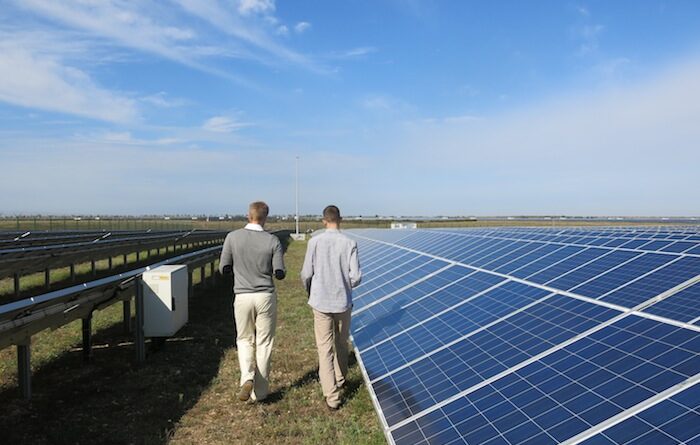Stanford Study Examines Hydrogen As A Commercially Viable Storage Medium For Renewable Energy
Stanford University has published a report outlining how excess renewable energy could be used to make hydrogen, which can then be sold to commercial users at a profit. But how lucrative would that business be? The answer is, it depends.
In a traditional electrical grid, there are three kinds of electricity. Some comes from nuclear or coal-fired generating facilities that produce a constant amount of electricity around the clock, day in and day out. Then there are other facilities — many of them powered by natural gas — that are started up every day during expected periods of high demand. Finally, there are so-called peaker plants. Also run by natural gas, they can be powered up and shut down quickly to meet short-term demand that the other plants can’t handle.

Renewable energy from solar panels and wind turbines upsets the apple cart when it comes to traditional grids. Sunlight and wind are variable, which means the supply of electricity can vary significantly during the course of a day, a week, a month, or a year. Sometimes, there is too much. For instance, Scotland now creates twice as much electricity from wind turbines than it needs, according to Science Alert. Sometimes, on the other hand, there is not enough electricity to meet demand.
New research by Stefan Reichelstein of Stanford University and Gunther Glenk of the Technical University of Munich suggests using excess renewable energy to make hydrogen could be profitable. Currently, hydrogen is used to make fertilizer, pharmaceuticals, and a host of other products, which means there is a well established market for it. Hydrogen can also serve as a medium for storing electricity until it’s needed
The study by Reichelstein and Glenk, published in the journal Nature Energy, involved a complex analysis of two commodities — electricity and hydrogen — whose prices rise and fall significantly over short periods of time. The question they asked is whether building a hydrogen production facility powered by electricity would be a sound business investment.
“From the standpoint of investors, it’s not helpful if your system generates power at times when prices are low,” Reichelstein says. “You want to find a different use for that power, so you don’t have to sell it at low prices. That’s why many people think hydrogen can play an important role in a decarbonized energy economy: You no longer rely on carbon dioxide emitting natural gas to produce hydrogen and you give renewables a revenue boost by not having to sell power at times with unfavorable market prices.” (The reference to natural gas isn’t because of its use in the electric grid, but because the vast majority of commercial hydrogen today comes from reforming natural gas, which leads to a lot of global warming emissions.)
The pair collected data on equipment costs and hydrogen prices, then compared it with hour-by-hour wholesale electricity prices and wind power generation data for a full year in both the US and Germany. After crunching all the numbers, they found that such hybrid energy systems break even if the hydrogen can sell for at least $3.50 per kilo.
Small and medium-scale buyers of hydrogen generally pay about $4 per kilo today, but larger customers pay closer to $3 per kilo. That makes the whole proposition rather risky, the researchers say, except for one thing. Prices for electrolyzers have been falling steadily over the past several years, just the way prices for solar and wind installations have fallen dramatically over the past 10 years. They are likely to keep falling as electrolyzers come into widespread usage.
 Chip in a few dollars a month to help support independent cleantech coverage that helps to accelerate the cleantech revolution!
Chip in a few dollars a month to help support independent cleantech coverage that helps to accelerate the cleantech revolution!
“The costs of electrolyzers are coming down in a similar fashion we have seen for renewable power generation,” Reichelstein says. “If that keeps up, hybrid energy systems will significantly advance the business case for both renewable power and carbon-free hydrogen.”
In an email to CleanTechnica, Mark Z. Jacobson, noted professor in Stanford’s Department of Civil and Environmental Engineering, said he agreed with the study’s conclusion that using excess wind and solar to produce hydrogen, which is then stored for later use, will help to keep costs down and stabilize the grid. Professor Jacobson and his colleagues came to a similar conclusion in a paper presented in 2015 entitled “Low-cost solution to the grid reliability problem with 100% penetration of intermittent wind, water, and solar for all purposes.”
A company in Western Australia already has a plan on the books to create the world’s largest hybrid wind and solar facility and then use the electricity from it to make hydrogen for export to its Asian neighbors. Hydrogen makes people nervous because it is the most reactive element in the periodic table. It is also highly explosive in certain circumstances. But if it can be made safely without using natural gas, it has the potential to make a major contribution to decarbonizing the environment.
If Reichelstein and Glenk are correct, cheaper electrolyzers could make hydrogen both abundant and affordable. Once that happens, worries about producing too much renewable energy that has to be “dumped” will become a thing of the past and fossil fuel apologists like the Heartland Institute will have to find something else to moan about.
Have a tip for CleanTechnica? Want to advertise? Want to suggest a guest for our CleanTech Talk podcast? Contact us here.
Latest CleanTechnica.TV Video

CleanTechnica uses affiliate links. See our policy here.

